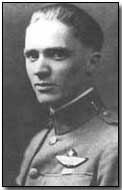Who's Who - Reed Landis
 Reed Gresham Landis (1896-1975)
achieved a dozen victories as a U.S.
air ace
during World War One, one of which was attained against a German
observation
balloon.
Reed Gresham Landis (1896-1975)
achieved a dozen victories as a U.S.
air ace
during World War One, one of which was attained against a German
observation
balloon.
An American, Landis largely served with the British Royal Flying Corps (RFC) in England, attached to 40 Squadron. Although he went on to serve with the U.S. 25th Aero Squadron Landis achieved all twelve of his air successes over a three month period while attached to 40 Squadron between 8 May and 19 August 1918.
Born in July 1896 the son of judge in Ottawa, Illinois, Landis was schooled in Chicago and attended the University of Chicago in 1916-17. In the latter year he left university and enlisted with the 1st Illinois Cavalry with the rank of private, and was sent on service to the Mexican border.
In June 1917 - in the wake of America's entry into the First World War - Landis received a transfer to the Signal Corps and an attachment to the latter's aviation division. Following rudimentary training Landis was despatched to Britain for flight training with the RFC in August 1917.
While with 40 Squadron Landis flew S.E.5a aircraft (with which he achieved all twelve of his successes). No further victories followed his re-assignment to command of 25th Aero with the rank of Major in September 1918 as part of the 4th Pursuit Group.
Landis, who received both the British Distinguished Flying Cross (DFC) and his own country's Distinguished Service Cross (DSC), went on to work as a pioneer in the civilian aviation sector following the armistice, working with American Airlines. He also served as chairman of the American Legion in addition to establishing an advertising business in Chicago (the Reed G Landis Company).
The return of war in the 1940s brought Landis recall to the Army Air Force in 1942, where he ultimately reached the rank of Colonel.
In 1919 (the same year he married Marion Keehn) he published his wartime memoirs as On the Roof of the War (and published Business Future of Aviation in the 1920s). He died in May 1975 aged 78 in Arkansas.
'White Star' was a German mixture of chlorine and phosgene gas, so-named on account of the identification marking painted on the delivery shell casing.
- Did you know?
